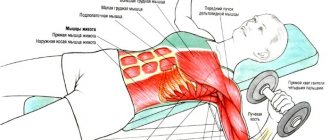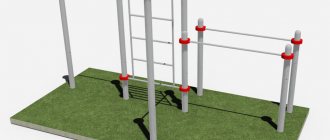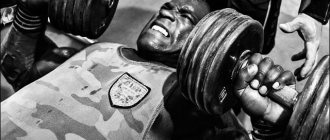For those who are in the hall for the first time
If this is your first time coming to the gym, you need to take into account your preparation. Often there is none at all. How to determine the working weight in this case? So far, no way.
People go to swing because they “already have the urge.” Therefore, the first training session is a very important moment. If you get a bad impression from (or after) her, you won’t come here a second time.
Usually the number of approaches and weight are selected by the trainer. Wait! Does the trainer have the necessary education and courses? Or is he just a home-grown muscleman who has achieved rapid progression through bad means? They are the ones to be afraid of.
The first training session should be an introductory one. We recommend not selecting weights yet, but taking what is not heavy for you at the moment. That is, if it’s a barbell, then it’s one that you can easily lift. After all, you will be lifting the barbell repeatedly, so even the weight that seems too light to you for one concept will put a noticeable load on the muscles. This is important not only for beginners, but also for guys weakened by a long break.
So, why is it important to work with minimal weights in the first workout:
- Your muscles don't know what hardware is.
- You don't have enough stamina yet.
- You don't know the technique of doing the exercises.
Simply put, you will easily get a sprain, or your muscles will be sore for a week after training. Believe me, after this the second time you are unlikely to want to come to the gym.
Correct selection of weights at the first visit - an empty bar for bench presses, dumbbells 2-5 kg for other exercises. If you want to squat, use an empty bar. Learn technique! And if the trainer tells you that the weight is light and you need to add more, don’t listen to him. This is the first training session.
There have been many cases when, after such training, a person has a fever for a week, and he cannot bend or straighten his arms. Why do you need this?
The first workout is a minimum of weights. The same goes for the number of approaches. We recommend doing 2 approaches. But you can get the program from the trainer. Or have a trainer show you what to do that day.
Example for beginners
The trainer told you to do 3 sets of all exercises. Reps: 10-15. Your task is to do 2 sets with the same number of repetitions. For bench press/squat/deadlift, it is better to take an empty bar or add 10 kg. Arm flexion-extension, dumbbell press – 5-6 kg. And isolated shoulder exercises are best done with 3-4 kg. You will understand why.
If everything comes very easily, most likely you are doing it wrong. In the case of dumbbell lateral raises, for example, if it’s easy for you, then most likely you bend your arms too much, or you haven’t turned your elbows up. Incorrect technique is easier to do. Remember!
How to correctly calculate the working weight in an exercise?
All exercises that athletes perform in gyms are usually divided into two main classes, isolating (single-joint) and basic (multi-joint), that is, they involve two or more joints when performing a working movement.
It is very important to choose the right working weight in basic exercises, because only they can significantly influence the growth of strength indicators and muscle mass (notably, they can also cause very serious injury to the athlete, so it is important not only to select the right weight during training, but and study thoroughly the technique of performing these exercises).
The basis for calculating working weight should be percentages (%) of the maximum possible weight that you can lift in a given specific exercise. For example, there are concepts that are closely related to the training program in the gym, such as light, medium, and heavy training. So, light training means the working weight in the exercise is 60-65% of the maximum, medium 70-75%, and heavy 80-85%.
Calculation of working weight in an exercise
Let us consider below, using a specific example, the calculation of the working weight when performing a barbell bench press while lying on a horizontal bench.
An example of calculating the working weight in the bench press
Suppose we found out that our maximum result in the barbell chest press is 90 kg , which means that the working weight, when converted to training taking into account the load, will look like this:
- if we have an easy workout: 90 * 0.6 (0.65) = 54 or 58.5 kg = 55-60 kg
- if the average workout: 90 * 0.7 (0.75) = 63 or 67.5 kg = 65-70 kg
- if hard training: 90 * 0.8 (0.85) = 72 or 76.5 kg = 75 kg
We round up to a whole number or a larger number, then during the training itself you can correct it (not important). You can see how to combine training with light, medium and heavy loads in the mass training program. As a rule, if an exercise is performed for 6 repetitions, then it is a heavy training, if for 8 - medium , if for 12 - easy .
As for calculating the working weight in isolating exercises, for example, dumbbell curls, dumbbell flyes on a horizontal bench, crossover, lying leg curls, and so on, there is no strict calculation, here you should focus more on your own sensations , taking into account the load you want to achieve and the number of repetitions you want to perform.
An example of calculating the working weight in the bench press
If you train hard, then at the end it should be really hard (but don’t push yourself to the point of complete failure, this is an extra, big stress for the body, after which it will need to be given a lot of time to recover ), if it’s average, then it shouldn’t be very hard, but it’s not easy either, if the load is light, then the exercise should be performed without unnecessary, excessive effort, in compliance with ideal technique .
After a long break
After a forced break in training, we recommend doing 2 sets instead of 3 or 4. And taking the weights 50% of those you used when you were still training. Yes, after training your muscles will ache. Strongly. But not so much that you fall behind schedule for a week.
In the future, you will gradually return to your working weights and begin to progress. Start small and increase the weight in each approach: for a barbell - by 10 kg, for dumbbells - by 2. You definitely won’t miss!
Bench press example
Warm up: empty bar, 20 reps. We weigh 10 kg and do a set. We hang another 10 and work. And so we reach 60 kg. If it becomes difficult in some approach, then there is no need to increase the weight in this workout. In the future, when it becomes difficult, add 1-2 kg and look at the result.
What is working weight
Working weight is the weight of the weight that is used during exercise.
If it is chosen optimally, you can do a certain range of repetitions with it in the correct technique, after which muscle failure occurs (the inability of the muscles to perform the movement) or 1-2 repetitions remain before it.
For example, you need to squat with a barbell 10 times. If you choose the right working weight, you will only be able to do 10 repetitions. At rep 11, muscle failure will occur or you will be close to it. Further performance of the exercise without damaging the technique will be impossible.
Weight selection during training
Now you know where to start training for the first time or after a long break. What to do next? And then we will learn to listen to our body and predict the desired weight.
The principle of any progress is to work at your maximum, “to failure.” The state of “failure” is a special feeling when you can no longer do a single repetition. Failure may occur earlier than planned if you choose too much weight. And later, if you made a smaller mistake.
For muscle growth, failure should occur within 6-12 repetitions. If less, you work on strength, if more, on endurance. Therefore, the weight is selected so that you can do at least 6 repetitions with it, but cannot do more than 12. How to guess this weight? By trial and error.
The first approach to any exercise is a warm-up. For example, before a bench press, you take an empty bar and do 15-20 repetitions with it. At this moment you can already feel how easy it is for you. You can compare this feeling with your last workout and roughly calculate the weight for this one.
When you start with light weights and gradually increase them, at some point you will get that precious number of pounds that you will work with until failure. We need to come to this.
This weight will increase from workout to workout. Slowly, but it will happen, believe me. Thus, when the required number of repetitions (6-12) and this weight comes easy to you, it’s a good sign to add 1-2 kg to the barbell. Or increase the number of repetitions if you do them less than 12. And then increase the working weight anyway, returning to the previous number of repetitions.
Finding the right weight right away, especially during the first workouts, is an impossible mission. That's why we start small. And the body itself decides what is enough for it and what is just right.
Initial weight selection algorithm[edit | edit code]
Let's say you decide to do an exercise such as a bench press. You have a specific scheme where it is recommended to do 6-10 repetitions in a working set. What weight should you use if you have never bench pressed before? We will experiment on ourselves.
SET THE AVERAGE WEIGHT (most often it is 40-50 kg for men) AND TRY TO DO 10 REPEATS.
- We got less (we did 8 and failure occurred) = we immediately chose the exact weight, because 8 is in the range of 6-10 repetitions
- We got the required number (we did 10 repetitions) = INCREASE THE WEIGHT (the load is too small, because failure did not occur in the range of 6-10)
ADD 5-10 KG. (if it was hard to push the 10th, then add 5 kg, if it’s easy, then add 10 kg.) That is. set 60 kg and do the next set of bench presses.
- We got less than 10 reps = BINGO (this is our working weight. We found it)
- We got the required amount (we did 10 repetitions) = INCREASE WEIGHT
ADD ANOTHER 5-10 KG. those. if we had 60 kg, then we set it to 65 kg or 70 kg. Let's do the 3rd approach.
- We got less than 10 = BINGO (this is our working weight)
- We got 10 = INCREASE WEIGHT.
- etc.
In this way we “probe” the required working weight. AFTER you do this once, you WILL ALREADY KNOW WHAT WEIGHT IS YOURS ON THE BAR in this exercise. Therefore, in your next training session you will not experiment. After warming up, you will take a working weight and perform the exercise with it. This will be the weight at which your muscles will grow best because failure will occur in the desired rep range.
Dependence of weights on training goals
When selecting weight, you can focus on the following criteria:
- If your goal is muscle and mass growth, failure should occur at 6-12 repetitions, as mentioned earlier. If you hit, say, on the eighth repetition, try doing the next workout 9. Then 10, 11, 12. After you complete 12 sets, add weight to the barbell.
- If your goal is to increase strength, the weights taken are more significant. Failure should occur before 6 repetitions. And you need to do few repetitions in the approaches.
- If you're doing endurance work, the weight used is reduced so you can do more reps. Failure should occur not at the 12th repetition, but at the 30th. In general, it’s better to go jogging. In your case, it is important to choose the type of sport, not the number of kg.
- Recovering from sprains requires light weights. You need to exercise for a very long time (months) with light weights, strengthening the healed ligaments. Haste is dangerous and inadvisable.
What to do for girls
It doesn't matter what gender you are. The mechanism of muscle progress is the same for everyone. The weights will just be different. A man squats with a weight of 100 kg, and a woman - 30-50, for example. The feeling is the same, the refusal is the same. The principles are the same, so feel free to use the above recommendations.
A separate article on our website is devoted to choosing the weight of dumbbells for women.
How to independently select the working weight of dumbbells and weights
The most important thing: there are no universal tables; choosing the weight of dumbbells per kilogram of body will not work (in fact, there are, but their effectiveness and safety are questionable). The basic rule that more experienced athletes use in the gym is targeting the point of failure. In another way, this point is called “muscle failure”, that is, the maximum weight is the one with which it is already difficult, but it is still possible to do 2-3 repetitions.
However, it is difficult for a beginner to understand where the point of failure is and what is “hard” or “impossible.” In addition, different weights should be used not only for different exercises, but also for different sets (sets of several repetitions). In other words, you need to select the number of weights on a barbell or dumbbell taking into account these training parameters.
It is better to write down all calculations (for example, enter them into the training schedule on your phone), since the weight is selected exclusively experimentally, and it is very difficult to remember all the numbers at once. Spend one workout on this, and then you will immediately put the required weight on the bar, plus this will give you the opportunity to observe your own progress.
Please note that the choice of weight for dumbbells, barbells or any other weight must be related to the exact number of repetitions. That is, if you train biceps with 5 kg dumbbells and perform the exercise 12 times in one set, write down these numbers. How do you know that 5 kg will be enough for such a set? If your arm “falls off” already on the 6th repetition, it means that the weight needs to be reduced, and if by the 10th time you were already tired, but were able to squeeze in a couple more (but no more), then this means that this is your weight specifically for this exercise, this set and this hand.
Always start with light weights and work your way up to the one that seems unusual to you. For example, if you have been engaged in intellectual work all your life, then dumbbells of 2-3 kg may already be significant, but if you have just recently returned from maternity leave and are accustomed to carrying a 12-kg child in your arms every day, then dumbbells of 5 kg are unlikely to impress you .
Select equipment for other muscle groups in the same way, but keep in mind that the larger they are, the more weight you will need. Don't compare them to each other: your legs and back are used to lifting more weights than your arms. Don’t compare yourself with others: you may have better developed arms, while someone else may have better developed legs.
By the way, exercises with free weights are usually harder to perform than lifting the same weight with the same muscle group on a machine. The fact is that blocks unload “extra” muscles and facilitate the training process, so you need to select larger numbers on the machine. The advantage of simulators is the correct technique for performing exercises, provided that you have already been taught how to use these simulators. In addition, if you can lift a barbell weighing 40 kg, this does not mean that you can easily lift two 20 kg dumbbells - the type of apparatus matters, simple mathematics does not work here.
If only an instructor is present in the gym, he can show the basic technique of working with both exercise machines and free weights and your body without using weights. Three things are important here: memory, a mirror and the absence of unnecessary ambitions. Carefully monitor the position of the body and limbs while performing exercises, and also do not proceed to increasing weight until you have driven the technique into muscle memory. Dumbbells that are too heavy can not only ruin the correct execution (which leads to loss of exercise effectiveness), but also lead to injuries.
Once you have selected a noticeable weight, start experimenting with it. Ideally, a set of 12 repetitions should exhaust your strength - at 8-9 repetitions the load should feel strong, and the 13th repetition is already difficult to do. If this is the case, congratulations, you have found the right weight.
As soon as you feel that the point of fatigue has moved from 8-9 repetitions to 10-12, add a little weight (by 0.5-1 kg). At the same time, the first repetitions in the approach should not be too simple - feel how the muscles work, or add weight. If the last jerks are difficult to complete, the dumbbells tend to fall out of your hands, and it is impossible to return the barbell to its place without outside help, the weight must be reduced.
Another time when you shouldn't put too many weights on the bar is light training, preparation for other types of fitness, recovery or toning/therapeutic fitness. Here the muscles do not need to be brought to the point of failure; warm them up with light dumbbells or an empty bar. High reps + light weight = endurance training, the inverse relationship trains muscle strength.
A weight that is too light will get boring, too heavy will quickly create a negative attitude towards the whole process.
And the last rule, but no less important: no other methods of selecting the weight of the projectile will work for you. Even if they are successfully used by a friend with exactly the same build and training experience. Experimenting with adjusting the weight of the weights can take you one workout, or several weeks or even months. Moreover, during this time you may already have progress, and all the values will have to be entered again.
But by that time the most important thing will appear - your personal experience. Once you understand how much you can lift, push, or squeeze, you can begin to adjust your training to increase endurance, strength, and predict progress.
What to do during a plateau
When you don’t feel a surge of strength for a long time, and your results barely stay at the same level, this means one thing - you have reached a plateau in your capabilities. Strength is not growing, there is no progress. And a bad mood and weak self-confidence often lead to a “kickback” of the security forces.
Now we need to be patient and work hard in the gym. Let the weights be the same. Try to increase them by 0.5 kg, at a minimum. Reconsider your lifestyle. Maybe it's not the training at all?
There is an opinion that to overcome a plateau during training you need to lose weight. As a rule, this option is good for those who take pharmacology, that is, for professional bodybuilders. So just be patient and maintain the level you have achieved. In 90% of cases, progress will come.
Weight selection for weight loss
It is believed that the best type of training for burning subcutaneous fat is intense cardio.
Running, cycling, Nordic walking, active gaming disciplines, plyometrics - all this, when used regularly, helps to get rid of extra pounds. As a rule, the effectiveness of such types of fitness depends on the time spent under load. Experts recommend doing aerobic training for at least 50-60 minutes 4-5 times a week. Recent studies by Western scientists have shown that when combining strength training with aerobic exercise, the rate of fat burning increases. This means that the most effective weight loss regimen combines gym fitness and cardio training. In this case, determining the weight of the shells is a strictly individual factor. It is necessary to choose a load that will allow you to do 15-20 full repetitions in each approach.
The basis of a fat burning program should be strength elements: deadlift, squat, chest press. These exercises should be distributed over 3 workouts per week. The initial weight of the weights should be small (for example, an empty 20 kg bar). Girls are allowed to do Romanian deadlifts with dumbbells instead of deadlifts. Additional exercises are performed at a fast pace. On rest days, you should do 60-minute cardio sessions (2-3 times a week).
Practical advice
- Keep a training diary. It should include the date of the lesson, the name of the exercise, the number of approaches and repetitions done, and the weights. You can choose the right working weight based on your own records. Your diary is the best adviser on what weight to start training with after a break, or where to start the next workout.
- Don't increase your weight suddenly. Many beginners do this: in the first workout they pressed an empty bar (20 kg), in the second it was 50 kg. This is stress for the muscles. Not every person will survive this easily. It is optimal to take steps of 10 kg. And if you have already exercised, you can raise the working weight by 40 kg in 4 approaches. At the same time, you will find out what your muscles are now capable of.
- When you immediately take the weight you think you need, you may make a mistake. That is, choose a heavy barbell weight. This will cause you to get tired before your work sets are completed. There is no need for any persistence here - remove a couple of weights from the barbell.
- Working “to failure” in the first workout is very dangerous. Just like the second one. The body should get used to the stress within a month. During this period, your task is not to chase the scales, but to practice your technique. If you can do more, that's good (that's what happens most often). Work on your movements, strengthen your ligaments.
What is refusal repetition, you ask.
Failure Rep (this is when muscle failure has occurred), muscle failure is the point at which performing an exercise with proper technique for another repetition on your own becomes impossible.
Those. Using the example of lifting a barbell for biceps (I told you above), failure occurs on the eighth repetition, that is, the athlete will no longer be able to handle the ninth. Therefore, this is the working weight.
Well, guys, these are the kind of witnesses that I should have explained at the very beginning, there is still a lot of information that you should know, this is just the beginning of our journey)).
The fact is that working weights in exercises are not static! Those. they, in accordance with the principle of load progression, must constantly change..., I already (in the distant past) ate all the baldness for myself and for you... and today I will eat it again...))), just in case, below I will give a list main articles on load progression (links below):
- Bodybuilding training programs (here, at the very beginning, it tells you step by step and explains how to use safe methods of progression, i.e. increasing weights and repetitions).
- German volumetric training (here we talk again about the same safe methods, but also about an unsafe method of load progression, for professionals).
- Natural bodybuilding muscles without steroids (it tells in principle why progression is needed, how to carry it out, etc., but not as detailed as in the first and second articles).
So, what am I talking about? => Most people (especially novice athletes) simply simply do not understand how to choose the weight for a particular exercise, + even if by some miracle they selected it once (and selected it correctly), then at the next workout it must change again, because, as I already said a little higher, the weight is not static... it must constantly change in accordance with the principle of load progression; if it does not change, muscle growth in principle becomes impossible. This is the dilemma we have to deal with.











